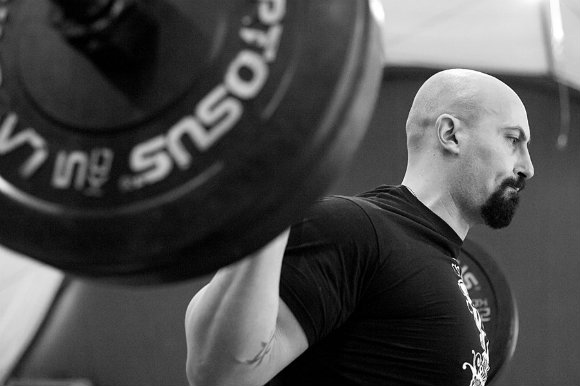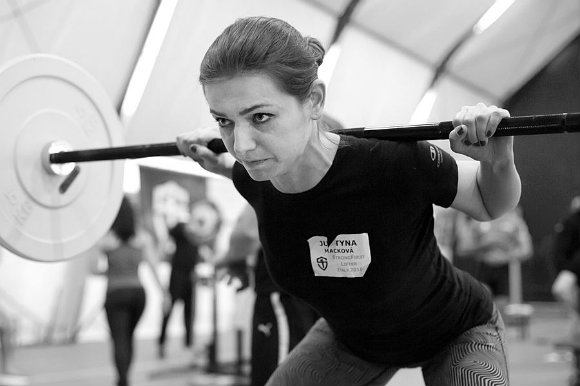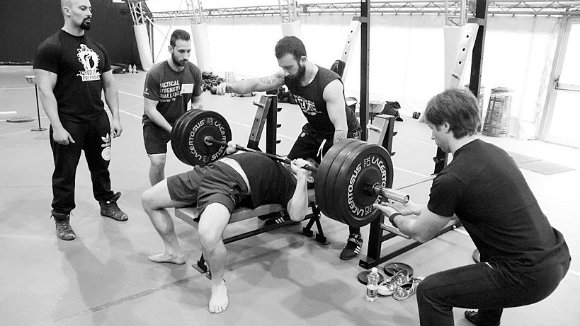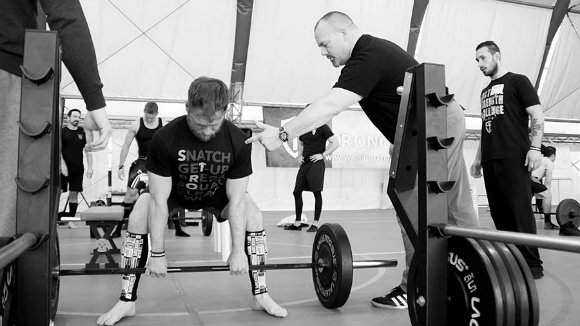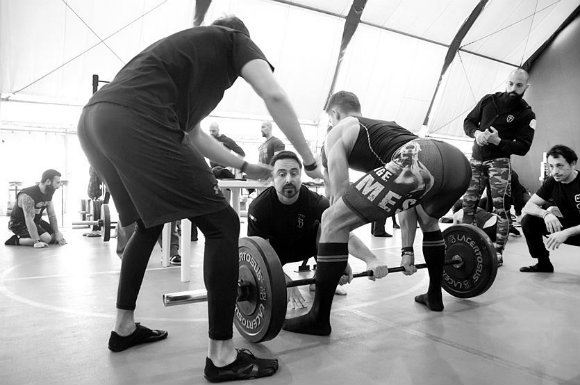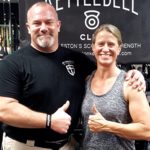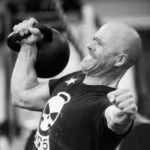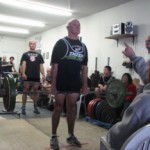The SFG is StrongFirst’s most well-known certification, and is widely considered the gold standard for kettlebell certification. But StrongFirst is more than kettlebells and the SFG. As students of strength, we learn to use multiple tools to achieve our goals, including one perhaps most vividly identified with strength: the barbell.
The StrongFirst Lifter Certification (SFL) is the barbell counterpart to the SFG. Like the SFG, the SFL is a rigorous weekend of training and evaluation that requires serious preparation. And, like the SFG, one of the biggest challenges for participants can be figuring out how to prepare for the SFL. This article is meant to serve as a guide to help you develop a plan to be ready for and get the most out of your SFL experience.
Why the SFL?
Why take the SFL at all? Here are a few possible reasons:
1. You are an SFG who wants to expand your understanding of the StrongFirst methods and philosophy.
StrongFirst’s methodology can be applied to more than kettlebell lifting. Many SFL attendees have noted that the understanding of programming and technique they gained at the SFL not only helped their barbell lifts, but also improved their kettlebell skills. If you want to understand the StrongFirst system in-depth, the SFL is a must.
2. You are a personal trainer who wants to incorporate safe, effective barbell training into your coaching.
It is possible to become an SFL without being an SFG (more on that below), and for some trainers, barbell training may be the more practical option. Kettlebells, while becoming more common, can be difficult to find, particularly in commercial gyms. Barbells, on the other hand, are available in almost any gym that allows even moderately serious strength training.
3. You already coach and use barbells in your training, but want to go more in-depth with your technique and programming.
If you are already familiar with the barbell, the SFL will help deepen and expand your knowledge of coaching, programming, and practicing the major barbell lifts. These are principles that can be applied to any coaching program, whether you are in a powerlifting gym, CrossFit box, or your local YMCA. Good training is good training.
The SFL is an in-depth look at barbell training, with a focus on seven major lifts: bench and military press; front, back, and Zercher squats; and the good morning. If that sounds like something that would make you a better coach, then the SFL is for you.
The Prerequisites for the SFL
The SFL stands out as the only StrongFirst Certification that requires specific prior training before attending the course. The rationale is simple—the SFL is a firehose of information, all of which is built on the foundation of StrongFirst principles. If you don’t understand those principles, you’re unprepared for the SFL.
The first option is to attend an eight-hour StrongFirst Kettlebell Users Course. That course will introduce you to the fundamental principles of StrongFirst, and is an appropriate option for those who are unlikely to make greater use of kettlebells in their own training or coaching.
The second option is to earn your SFG Level I Certification. This is the more arduous choice, but will ensure that you have a deeper understanding of the StrongFirst methodology and philosophy. If you use kettlebells extensively, this is the superior option—and the SFG Level I is a Certification you will want anyway.
The SFL Strength Tests
The SFL begins with two strength tests: a bench press and a deadlift. All of the test lifts are based upon your bodyweight, which is rounded up to the nearest five pounds. That means the difference between you weighing 174 pounds and 176 pounds can turn into as much as ten additional pounds on your deadlift. That may not sound like much, but it can be enough to tip the balance against you. If you feel like you need to take care of your weight, start early.
Test 1: The Bench Press
The first lift tested in the SFL is the bench press: men must press 1.25x bodyweight for a single rep. Women must press 3/4 bodyweight, again for single. Challenging weights, but not out of reach for most lifters.
For many SFL attendees, the weight is not the greatest challenge. It is the structure of the test that dooms them to failure. You cannot lie down on the bar, grab the weight, bounce it off your chest, and call it a day. You must unrack the bar, wait for a press command, bring the bar to your chest, pause, press the bar, then wait for the rack command. Not waiting for the proper commands seems to be the number one reason people fail the bench press test.
How do you avoid this? Practice! In the test, you will be given the option of accepting a lift-off or not. You will also have the option of receiving a press command or not. Whichever way you prefer, practice your choices in advance. If you want a lift-off and press command, then have your training partner give you both during training.
Note: The press command is given when the bar is motionless on your chest. If you are not going to opt for a press command, make sure you are practicing pausing at the bottom of your press and at the top. If you slam the press up, but rack it before the command is given, you’ll fail the test.
Test 2: The Deadlift
Like the bench press, the deadlift strength test is a single rep. Double bodyweight for men, one-and-a-half times bodyweight for women. Again, challenging, but not insurmountable.
This test is more straightforward: there is a “down” command given at the top of the deadlift, but pausing at the top of the lift seems more instinctive for most people. You must set the bar down under control, so don’t get used to dropping it. Your hands need to follow the bar down.
You will need to wear long socks while you’re deadlifting. If you have not done this before, again, practice. It’s a little thing, but the little things can be what throws you off. The first time you try lifting in your spiffy new compression socks shouldn’t be the day of the SFL.
How to Prepare for the SFL: Get a Coach
Offering specific programming to prep you for these strength tests is beyond the scope of this article. If you need help designing a program, seek a qualified coach, or look at some of the programs listed at the end of this article.
In fact, getting a coach is the single biggest thing you can do to make your SFL prep easier. A coach who has earned the SFL already is an ideal choice, but a good powerlifting coach will also serve. You want someone who understands the technique of lifting, and who will be able to help you not only get stronger, but develop technical skill, as well.
The Weekend Itself
Once you’re done with the strength tests, the learning commences. Three days of barbell lifting, with four programming lectures, and a lot of physical practice.
Make sure your mobility is dialed in, especially for the squats and the military press (this will also be important when technique testing comes). Your hips, shoulders, and thoracic spine will be important areas, but make sure you’re covering all your bases. If you can, get an FMS done ahead of time, and deal with any major restrictions.
Do not neglect strength endurance work. It’s easy to look at the SFL requirements and assume the course is about max effort lifts all day. While it’s true that barbell lifting is a great way to build maximal strength, the reality is you’ll be doing a lot of lifting over the weekend. Without some strength-endurance work, the weekend can be brutal. Fortunately, you’ll have already learned the fundamentals of kettlebell work (either in your Kettlebell Users Course or SFG Level I Certification), and the kettlebell is a great tool for developing strength-endurance. Do not ignore your kettlebell while prepping for the SFL.
As noted earlier, there are four programming lectures spaced out throughout the weekend. This is a lot of information, but also a great opportunity to ask questions and get feedback. If you have specific concerns or questions about barbell lifting, bring them, and plan to take notes.
Be prepared to help your training partners. Chief SFL Doc Hartle often reminds attendees that this is an instructor certification. Practice instructing. Don’t just hang out and watch your partners struggle.
SFL Technique Testing
At the end of the SFL, you will be tested on three lifts: military press, back squat, and deadlift. Practice these lifts in advance. All of these tests are done for five (not one) repetitions. Yes, you will get adjustments and coaching throughout the weekend, but coming in with a blank slate is going to make the lifts much harder.
- Military Press: Men must press 2/3 bodyweight, women 1/2 bodyweight, rounded up to the nearest 5lbs. You will be given a press command to start, and a count at the top of each lift. Get used to pausing with the bar locked out overhead. This is a place where mobility restrictions will really hurt you, so make sure you’ve cleared those up.
- Back Squat: Men must squat bodyweight, women 3/4 bodyweight, rounded up to the nearest 5lbs. Again, you will be given a count at the top. Get used to pausing there (no pause at the bottom is needed). Also, make sure you’re hitting depth (below parallel). The weight on these is relatively light compared to the other test lifts, but again, mobility restrictions will doom you.
- Deadlift: Men must deadlift 1.5x bodyweight, women bodyweight, rounded up to the nearest 5lbs. If you can pass the strength test, you are strong enough to make this lift, but it is five reps. Make sure you take some time during your preparation training to practice doing five good reps in a row.
These last three lifts are technique tests, which means you will be judged closely on your form and performance. You’ll get a lot of great feedback over the weekend, but if you can do some work in advance, it will be much smoother for you.
Some General Survival Tips
- Bring food and water. The SFL is not as grueling as the SFG, but they are still long days and you will be lifting a lot of weights.
- You will have breaks. Use them wisely. Learn what you can about the location in advance, and either find a good place to eat or bring your own food.
- Doc Hartle likes Guinness and chocolate chip cookies. Just saying.
Resources to Prepare for the SFL:
- Kettlebells and Deadlifts Go Together Like Vodka and Pickles
- Kettlebells and Deadlifts II
- The Secret to Big Deadlifts: Do the Small Things
- How I Got a Nearly 10% Bigger Bench Press in 2 Months
- Build a Barbell Military Press on a Kettlebell Foundation
Click here for more details and the upcoming schedule of SFL Certifications.
